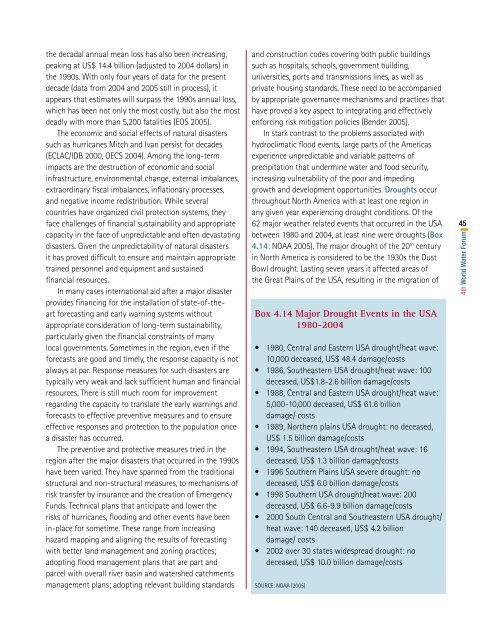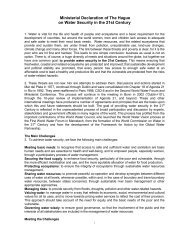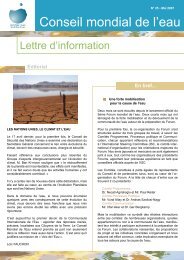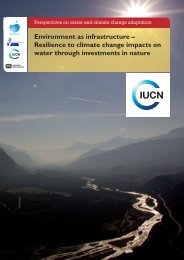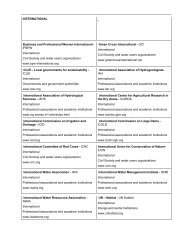Americas ok.indd - World Water Council
Americas ok.indd - World Water Council
Americas ok.indd - World Water Council
You also want an ePaper? Increase the reach of your titles
YUMPU automatically turns print PDFs into web optimized ePapers that Google loves.
the decadal annual mean loss has also been increasing,peaking at US$ 14.4 billion (adjusted to 2004 dollars) inthe 1990s. With only four years of data for the presentdecade (data from 2004 and 2005 still in process), itappears that estimates will surpass the 1990s annual loss,which has been not only the most costly, but also the mostdeadly with more than 5,200 fatalities (EOS 2005).The economic and social effects of natural disasterssuch as hurricanes Mitch and Ivan persist for decades(ECLAC/IDB 2000, OECS 2004). Among the long-termimpacts are the destruction of economic and socialinfrastructure, environmental change, external imbalances,extraordinary fiscal imbalances, inflationary processes,and negative income redistribution. While severalcountries have organized civil protection systems, theyface challenges of financial sustainability and appropriatecapacity in the face of unpredictable and often devastatingdisasters. Given the unpredictability of natural disastersit has proved difficult to ensure and maintain appropriatetrained personnel and equipment and sustainedfinancial resources.In many cases international aid after a major disasterprovides financing for the installation of state-of-theartforecasting and early warning systems withoutappropriate consideration of long-term sustainability,particularly given the financial constraints of manylocal governments. Sometimes in the region, even if theforecasts are good and timely, the response capacity is notalways at par. Response measures for such disasters aretypically very weak and lack sufficient human and financialresources. There is still much room for improvementregarding the capacity to translate the early warnings andforecasts to effective preventive measures and to ensureeffective responses and protection to the population oncea disaster has occurred.The preventive and protective measures tried in theregion after the major disasters that occurred in the 1990shave been varied. They have spanned from the traditionalstructural and non-structural measures, to mechanisms ofrisk transfer by insurance and the creation of EmergencyFunds. Technical plans that anticipate and lower therisks of hurricanes, flooding and other events have beenin-place for sometime. These range from increasinghazard mapping and aligning the results of forecastingwith better land management and zoning practices;adopting flood management plans that are part andparcel with overall river basin and watershed catchmentsmanagement plans; adopting relevant building standardsand construction codes covering both public buildingssuch as hospitals, schools, government building,universities, ports and transmissions lines, as well asprivate housing standards. These need to be accompaniedby appropriate governance mechanisms and practices thathave proved a key aspect to integrating and effectivelyenforcing risk mitigation policies (Bender 2005).In stark contrast to the problems associated withhydroclimatic flood events, large parts of the <strong>Americas</strong>experience unpredictable and variable patterns ofprecipitation that undermine water and food security,increasing vulnerability of the poor and impedinggrowth and development opportunities. Droughts occurthroughout North America with at least one region inany given year experiencing drought conditions. Of the62 major weather related events that occurred in the USAbetween 1980 and 2004, at least nine were droughts (Box4.14: NOAA 2005). The major drought of the 20 th centuryin North America is considered to be the 1930s the DustBowl drought. Lasting seven years it affected areas ofthe Great Plains of the USA, resulting in the migration ofBox 4.14 Major Drought Events in the USA1980-2004• 1980, Central and Eastern USA drought/heat wave:10,000 deceased, US$ 48.4 damage/costs• 1986, Southeastern USA drought/heat wave: 100deceased, US$1.8-2.6 billion damage/costs• 1988, Central and Eastern USA drought/heat wave:5,000-10,000 deceased, US$ 61.6 billiondamage/ costs• 1989, Northern plains USA drought: no deceased,US$ 1.5 billion damage/costs• 1994, Southeastern USA drought/heat wave: 16deceased, US$ 1.3 billion damage/costs• 1996 Southern Plains USA severe drought: nodeceased, US$ 6.0 billion damage/costs• 1998 Southern USA drought/heat wave: 200deceased, US$ 6.6-9.9 billion damage/costs• 2000 South Central and Southeastern USA drought/heat wave: 140 deceased, US$ 4.2 billiondamage/ costs• 2002 over 30 states widespread drought: nodeceased, US$ 10.0 billion damage/costsSOURCE: NOAA (2005)454th <strong>World</strong> <strong>Water</strong> Forum


